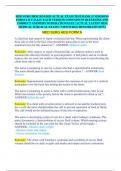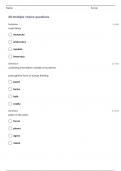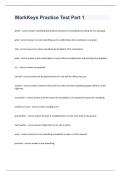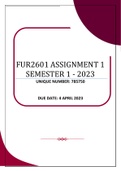MED SURG HESI 20 24-2025 ACTUAL EXAM TEST BANK ( 5 VERSIONS FORM A B C D & E) EACH VERSION CONTAINS 55 QUESTIONS AND CORRECT ANSWERS WITH RATIONALES | ACTUAL LATEST HESI MEDICAL SURGICAL EXAMS / MED SURGE HESI (BRAND NEW) MED SURG HESI FORM A A client has had surgery to repair a fractured left hip. When repositioning the client from side to side in the bed, what should the nurse plan to use as the most important item for this maneuver? - ANSWER -Abductor splint Rationale: After surgery to repair a fractured hip, an abductor splint is used to maintain the affected extremity in good alignment. A bed pi llow and an overhead trapeze also are used, but neither is the priority item to be used in repositioning the client from side to side The nurse is preparing to care for a client who had a supratentorial craniotomy. The nurse should plan to place the clien t in which position ? - ANSWER -Semi Fowler's Rationale: Supratentorial craniotomy means the exposure of any part of a cerebral hemisphere over the basal line joining the nasion to the inion. The nurse is preparing to assist a client with a cuffed tracheostomy tube to eat. What intervention is the priority before the client is permitted to drink or eat? - ANSWER -Inflate the cuff Rationale: If a client with a tracheostomy is allowed to eat and the tracheost omy has a cuff, the nurse should inflate the cuff to prevent aspiration of food or fluids. The cuff would not be deflated because of the risk of aspiration. The nurse is developing a plan of care for a client with Cushing's syndrome. The nurse documents a client problem of excess fluid volume. Which nursing actions should be included in the care plan for this client? Select all that apply. - ANSWER -- Monitor d aily weight. - Monitor intake and output. - Assess extremities for edema Rationale: The client with Cushing's syndrome and a problem of excess fluid volume should be on daily weights and intake and output and have extremities assessed for edema. He or s he should be maintained on a high -potassium, low -
sodium diet. A client with an external arteriovenous shunt in place for hemo dialysis is at risk for bleeding. Which is the priority nursing intervention? - ANSWER -Ensure that small clamps are attached to the arteriovenous shunt dressing. Rationale: An external arteriovenous shunt is a less common form of access site but carries a risk for bleeding when it is used because 2 ends of an external cannula are tunneled subcutaneously into an artery and a vein, and the ends of the cannula are joined. If accidental disconnection occurs, the client could lose blood rapidly. For this reason , small clamps are attached to the dressing that covers the insertion site for use if needed. The shunt site also should be assessed at least every 4 hours. Checking the shunt for the presence of bruit and thrill relates to patency of the shunt. Although c hecking the results of the prothrombin time is important, it is not the priority nursing action. A client is admitted to the hospital emergency department after receiving a burn injury in a house fire. The skin on the client's trunk is tan, dry, and hard. It is edematous but not very painful. The nurse determines that this client's burn should be classified as which type? - ANSWER -Full-thickness Rationale: Full-thickness burns involve the epidermis, the full dermis, and some of the subcutaneous fat layer. The burn appears to be a tan or fawn color, with skin that is hard, dry, and inelastic. Edema is severe, and the accumulated fluid compresses tissue underneath because of eschar formation. Some nerve endings have been damaged, and the area may be insensit ive to touch, with little or no pain. The nurse is assessing a client with a duodenal ulcer. The nurse interprets that which sign or symptom is most consistent with the typical presentation of duodenal ulcer? - ANSWER -Pain that is relieved by food intake Rationale: The most typical finding with duodenal ulcer is pain that is relieved by food intake. The pain is often described as a burning, heavy, sharp, or "hunger pang" pain that often localizes in the mid -epigastric area The nurse has implemented a bowel maintenance program for an unconscious client. The nurse would e valuate the plan as best meeting the needs of the client if which method was successful in stimulating a bowel movement? - ANSWER -
Glycerin suppository Rationale: The least amount of invasiveness needed to produce a bowel movement is best. Use of glycerin suppositories is the least invasive method and usually stimulates bowel evacuation within a half -hour. A client is readmitted to the hospital with dehydration after surgery for creation of an ileostomy. The nurse assesses that the client has lost 3 lb of weight, has poor skin turgor, and has concentrated urine. The nurse interprets the client's clinical picture as correlating most closely with recent intake of which medication, which is contraindicated for the ileostomy client? - ANSWER -Biscodyl Rationale : The client with an ileostomy is prone to dehydration because of the location of the ostomy in the gastrointestinal tract and should not take laxatives The client is complaining of skin irritation from the edges of a cast applied the previous day. Which action should the nurse take? - ANSWER -The nurse petals the edges of the cast with tape Rationale: minimize skin irritation. The nurse is taking a health history for a client with hyperparathyroidism. Which question would elicit information about this c lient's condition? - ANSWER -"Are you experiencing pain in your joints?" Rationale: Hyperparathyroidism is associated with over secretion of parathyroid hormone (PTH), which causes excessive osteoblast growth and activity within the bones. When bone reabso rption is increased, calcium is released from the bones into the blood, causing hypercalcemia. The bones suffer demineralization as a result of calcium loss, leading to bone and joint pain A client with type 2 diabetes mellitus has a blood glucose level g reater than 600 mg/dL (34.3 mmol/L) and is complaining of polydipsia, polyuria, weight loss, and weakness. The nurse reviews the health care provider's documentation and expects to note which diagnosis? - ANSWER -Hyperosmolar hyperglycemic syndrome (HHS) Rationale : HHS is seen primarily in clients with type 2 diabetes mellitus, who experience a relative deficiency of insulin. The onset of signs and symptoms may be gradual. Manifestations may include polyuria, polydipsia, dehydration, mental status alterations, weight loss, and weakness. The nurse is developing a plan of care for a client who will be admitted to the hospital with a diagnosis of deep vein thrombosis (DVT) of the right leg. The nurse develops the plan, expecting that the health care provider (HCP) will most likely prescribe which option? - ANSWER -Maintain activity level as prescribed. Rationale: Standard management for the client with DVT includes maintaining the activity level as prescribed by the health care provider; limb elevation; relief of discomfort with warm, moist heat; and analgesics as needed. Recent research is showing that ambulation, as previously thought, does not cause pulmonary embolism and doe s not cause the existing DVT to worsen. Therefore, the nurse should maintain the prescribed activity level, which could be bed rest or ambulation. A client with a history of ear problems is going on vacation by aircraft. The nurse advises the client to include which activities to prevent barotrauma during ascent and descent of the airplan e? Select all that apply: - ANSWER -- Yawning - Swallowing - Chewing gum - Sucking on a hard candy Rationale: Clients who are prone to barotrauma should perform any of a variety of mouth movements to equalize pressure between the ear and the atmosphere, particularly during ascent and descent of an aircraft. These can include yawning, swallowing, drinking, chewing, and sucking on hard candy. Valsalva maneuver also may be helpful. The client should avoid sitting with the mouth motionless during this time because the resulting lack of pressure change in the ear will contribute to pressure buildup behind the tympanic membrane. The nurse is assessing a client with an abdominal aortic aneurysm. Which assessment finding by the nurse is unrelated to the aneurysm? A. Pulsatile abdominal mass







